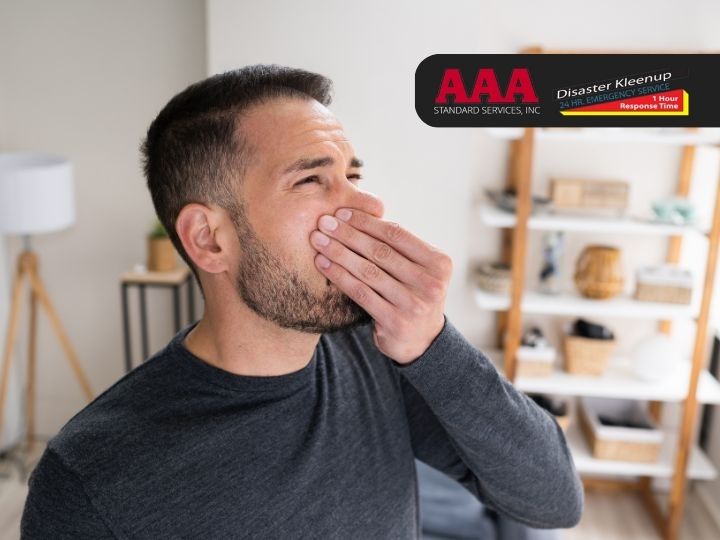Navigating through an unpleasant smell of smoke in your household or vehicle can be an unwanted, headache-inducing experience. In this comprehensive guide, we’ll unearth the science behind smoke odor and its physical impact, along with exploring its common occurrences in houses and vehicles. We’ll provide you with measures to prevent smoke odor and share some DIY methods along with commercial products used for smoke odor elimination. Discover when it’s time to call a pro and how to choose the right one for you. Finally, delve into long-term solutions that ensure a fresh, smoke-free environment, with the guidance and insight from the professionals at AAA Standard Services, Inc.
Understanding Smoke Odor
The term “smoke odor” refers to the unpleasant smell left behind by fire and smoke. It’s a combination of several distinct fragrances generated by the incomplete combustion of different materials.
The Science Behind Smoke Odor
When items burn, the molecules that make up these objects get dispersed into the air. These molecules then bond with other pollutants in the air to create the bothersome aroma we associate with fire. It sticks to surfaces, clothing, and even gets absorbed by porous materials like fabric, wood, and drywall, making smoke odor difficult to get rid of permanently.
Types of Smoke Odor
There are various types of smoke odors depending upon what is on fire. The smell of a wood-burning fireplace is distinct from that of burnt food in the kitchen or a fire caused due to a burnt plastic in the house. Each requires a unique method for odor removal based on the specifics of the material burned.
Physical Impacts of Smoke Odor
The lingering smell of smoke can be more than just an irritant to the nose. Continuous exposure to smoke odor can cause headaches, eye irritation, or cause sinus problems. Moreover, the most damaging impacts are when the smoke odor is due to highly toxic substances such as burning plastic, causing respiratory problems and at worst, ailments like lung cancer upon prolonged exposure.
Smoke Odor in Households
Domestic spaces are prone to various causes of smoke odor, from everyday activities to unfortunate incidents
Common Causes
The common causes of smoke odor in households include cooking mishaps, fire accidents, misuse of electricity or electronics, and indoor smoking. The smoke from these situations leaves behind an unpleasant smell that lingers in the interior of the house.
Locations in Home Prone to Smoke Odor
Areas in the house like the kitchen, living room (especially if you have indoor fireplaces), and rooms where people smoke are more susceptible to smoke odors. These odors can cling to fabrics and get embedded in upholstery, rugs, carpets, curtains, and even walls.
Smoke Odor in Vehicles
Just like homes, vehicles too, can be affected by unpleasant smoke odors, impacting not just the comfort but also the resale value of the vehicle.
Common Causes
Smoking in cars is a primary culprit behind the smoke odor. In addition, electrical malfunctions and fires within vehicles can also lead to a pervasive smoke smell.
Areas in Vehicles Prone to Smoke Odor
Inside vehicles, smoke odor can permeate almost all parts, but the fabric and upholstery of the seats, carpets, and roof liner are particularly susceptible to harboring the smell. The odor can also get trapped in air conditioning and heating systems, spreading the smell whenever they are in use.
Basic Preventive Measures against Smoke Odor
Prevention is always better than the cure, and the same applies to smoke odor.
Maintaining Cleanliness
Regular cleaning of homes and vehicles can help prevent smoke odors from settling. This includes regular dusting, vacuuming, and washing of fabrics and upholstery.
Avoiding Indoor Smoking
Eliminating indoor smoking can drastically reduce the risk of lingering smoke smells. This is true for both homes and vehicles.
Good Ventilation Practices
Keeping your spaces well-ventilated helps disperse smoke particles in the air, preventing them from settling on surfaces and causing an odor.
Smoke Odor Removal Methods
When preventative measures aren’t enough, or the smoke odor is already present, there are several removal methods you can employ.
DIY Smoke Odor Removal Techniques
Several household items can be used to eliminate smoke odor. The most popular are baking soda, vinegar, and activated charcoal.
Commercial Smoke Odor Removal Products
If the DIY approach isn’t working, there are plenty of commercial products designed specifically for dealing with smoke odor. From sprays to candles and odor absorbers, these products can effectively neutralize smoke smells.
Professional Smoke Odor Elimination
In severe cases, or when the DIY and commercial products aren’t enough, it might be time to call in professionals.
When to Hire a Professional
Professionals should be considered when the smoke odor is so intense that it significantly impacts the comfort of living or when it is caused by a large-scale incident like a house fire.
Processes Involved
Professional smoke odor elimination involves using industrial-grade equipment and chemicals to deep clean and deodorize affected areas. These professionals also possess the knowledge to deal with smoke odors that have penetrated into hard-to-reach spaces.
Choosing the Right Professional
When hiring a professional, it’s crucial to ensure they’re experienced, certified, and reputable. Not only will they more effectively eliminate smoke odors, but they’ll do so in a way that is safe and minimally disruptive.
Long Term Solutions for Smoke Odor
There are several long-term solutions one can incorporate for managing smoke odors.
Investing in Air Purifiers
Air purifiers can help keep the air in your spaces cleaner and fresher smelling. They can trap tiny smoke particles that cause odors and even filter out other allergens and pollutants.
Regular Maintenance Practices
Regularly cleaning and airing out your spaces can prevent smoke odor build-up. Maintenance checks on electrical devices can also prevent malfunctions that lead to fires and subsequent smoke odors.
Building a Smoke-Free Environment
Eliminating sources of smoke like cigarettes and candles, ensuring safe techniques in cooking, maintaining electrical devices, and using fragrance-free products can all contribute to building a smoke-free environment that is resistant to smoke odors.
1. What are the common methods of smoke odor elimination?
Common methods of smoke odor elimination encompass using air purifiers, odor absorbers, and cleaning solutions. Proper ventilation and deep cleaning of affected areas also prove effective in removing smoke odor.
2. How effective are air purifiers in eliminating smoke odor?
Air purifiers can significantly minimize smoke odors as these appliances use filters or ionization to trap and neutralize odor-causing particles. However, effectiveness depends on the specific model and its features.
3. Can odor absorbers completely eliminate smoke odor?
Odor absorbers, like baking soda or activated charcoal, can absorb smoke smells to a great extent but may not entirely eliminate the odor if the contamination is severe. These are most effective when used along with other smoke odor elimination methods.
4. Which cleaning solutions are effective for smoke odor elimination?
Specific cleaning solutions, such as those containing vinegar, ammonia, or trisodium phosphate, can effectively neutralize smoke odor. Choosing the best cleaning solution depends on the affected material and intensity of the smoke smell.
5. How can proper ventilation help in smoke odor elimination?
Optimal ventilation helps in circulating fresh air and removing the stagnant air laden with smoke odor. Open windows and doors, and use fans for promoting effective airflow and quicker odor dissipation.
6. Are there any professional tools for smoke odor elimination?
Professional tools like ozone generators, hydroxyl technology, and thermal fogging machines are often used to combat severe smoke odor issues. These tools generate substances that can neutralize smoke odor at its source.


